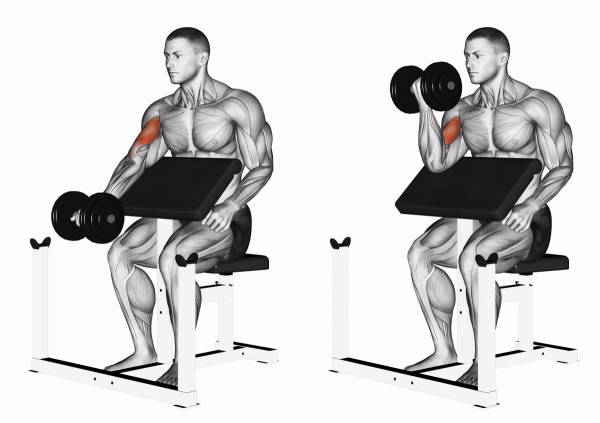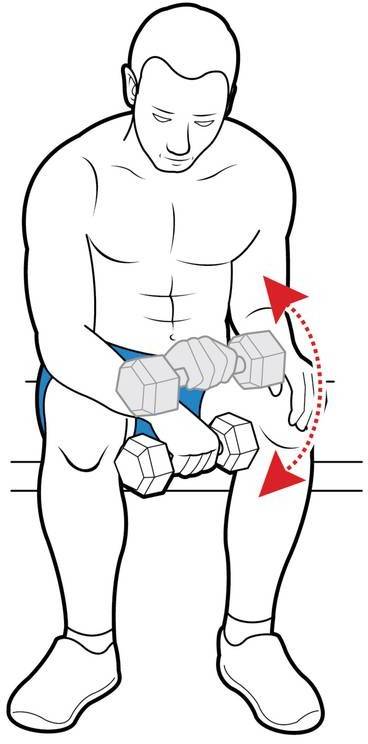You’ve been pounding out curls every day at the gym, trying to build bigger arms. You have noticed some impressive results, but there’s just one problem: your arms aren’t wide enough.
When you build bigger biceps sans width, they’re going to look great from the side, but somewhat awkward from a frontal view. Read on to find some easy steps to build phenomenal arms.
Focus on the Pump, Rather Than Presses
This is arguably the most important tip for building bigger arms. Many beginners make the mistake of focusing on presses when they exercise their arms. This may burn some calories, but won’t do much good for building muscle.
What you need to do is try to get a pump, so that your muscles get the blood and nutrients they need for growth.
The pump also stretches your fascia, which is the tight sheath surrounding your muscles. If the fascia is too tight, it’s going to prevent your muscles from growing. But when you pump, you’re putting an expansive force against this sheath, creating more room for muscle growth.
For best results in increasing the width of your arms, focus on the pump with every arm exercise that you do, whether it’s bench presses or incline dumbbell curls.
Don’t Forget Your Triceps
You’re focusing on your biceps and working out your forearms regularly as well. But if your arms aren’t growing in width, it’s likely because you’re not focusing on the right muscles: your triceps.
Although they’re the largest muscle group around the arm, triceps are often forgotten when people try to build bigger arms. When you develop your triceps, your arms will look big even when you’re not flexing them. Here are some useful tips to help you build your triceps:
- In addition to your usual exercises, be sure to include shoulder presses, bench presses, and dumbbell presses.
- To ensure that each head of the triceps gets the same level of development, switch between extension movements using cables, dumbbells, and barbells to ensure that the triceps are worked on from different angles.
- Building width requires building mass. To add mass onto your triceps, start incorporating heavy weights, weighted dips, and close-grip bench presses into your workout routine.
You can further concentrate on the weak points in your triceps with the reverse cable pushdown. All you need to do is use a reverse grip to hold an overhead cable, and then extend your arm straight down without bending your elbows. This will work on the insides of your arms and effectively build mass around the area.
All of the Curls
You already know that curls are important for building bigger arms. But are you training with the right curls to get wider arms?
There are a few types of curls that will leverage your efforts at building the width of your arms:
Preacher curls
Preacher curls help in developing your lower bicep areas. Keep the preacher bench against your chest with your arms extended over it. In this position, your arms will be at an angle in which the lower parts of your muscles receive more stress.
Make sure you fully extend your arm at the bottom of each rep, and resist the weight as you do so. Avoid leaning back, so that your biceps get stressed for optimum growth.

Standing bicep curls
With standing bicep curls, you’re going to develop the overall mass of your biceps. They aren’t as complicated as preacher curls, but are highly effective for building bigger arms.
Keep your feet shoulder-width apart, use an underhand grip to hold the bar, and make sure your hands are shoulder-width apart as well. Make sure your elbows are not moving and are positioned close to your body.
The path of the bar should be a wide arc away from the body, on both the upward and downward portions of the movement.
Hammer curls
Hammer curls involve holding and moving a dumbbell as if it’s a hammer pounding a nail. The difference is that you need to do this slowly. Squeeze your upper arms hard when you bring the dumbbells towards the top. This will result in maximum pump effect, boosting your efforts for wider arms.
Maximize your efforts by switching to equipment with thicker bars. These types of bars will not only help you develop your upper body strength, but also develop more muscles around your arms. Try incorporating them into exercises that require the use of equipment such as dumbbell curls and incline curls.
Give Your Forearms Some Love
If you really care about having sensational arms, you’ll want to avoid “turkey wings.” You don’t want huge and wide biceps with forearms that are skinny and underdeveloped.
If you really want wider arms, you need to distribute your efforts evenly across your biceps, triceps, and forearms. You can isolate your forearms in training just like any other part of your body, and developing them will give you the strength to advance to heavier weights in a variety of other exercises. Here are some of the forearm training exercises you can use:
Wrist curls
Wrist curls work on the inner muscles of your forearms. To perform this exercise, straddle a bench and rest your forearms on top of it, with your wrists and hands hanging over the end.
Use an underhand grip to hold a barbell and stabilize your elbows by locking your knees in against them. Bend your wrists to lower the weight down slowly towards the floor.
Once you’ve reached your limit, loosen your grip to allow the weight to roll down out of your palms with your fingers supporting it. Wait a few seconds, and then roll the weight back up as far as possible without lifting the forearms.

Reverse wrist curls
In addition to working your forearm, reverse barbell curls also work on the outer areas of your biceps. The best way to perform this exercise is on a preacher bench.
Keep your hands 10 inches apart, and use an overhand grip on the barbell. The idea is to make sure your arms are parallel to the floor. Now bend your wrists forward while lowering the bar as much as possible.
Once you’ve reached your limit, bring your wrists back up without moving your forearms.
Eat Right to Get Big
Protein fuels muscle growth, so you’re going to need to increase your protein intake significantly in order to build your muscle size and width. If you’re not already consuming a protein-rich diet, make sure you start adding healthy proteins like lean meat, eggs, and yogurt into your daily diet.
If you find yourself fighting genetics, work with supplements that leverage your muscle-building efforts. These will help make up for your body’s reluctance to grow muscles on its own.
But make sure you choose the right supplements and take them correctly to avoid any detrimental effect they could have on your overall health. The best thing is to consult your trainer regarding this.
It’s important to remember that supplements should not be considered as a fast-track solution for bigger muscles, and should only be taken as advised.






